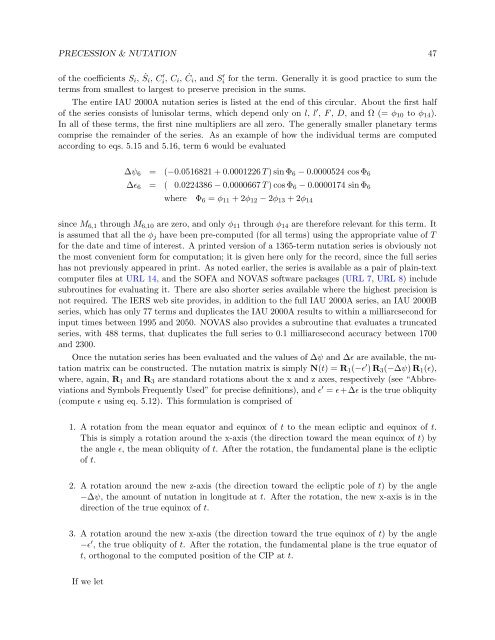USNO Circular 179 - U.S. Naval Observatory
USNO Circular 179 - U.S. Naval Observatory
USNO Circular 179 - U.S. Naval Observatory
You also want an ePaper? Increase the reach of your titles
YUMPU automatically turns print PDFs into web optimized ePapers that Google loves.
PRECESSION & NUTATION 47<br />
of the coefficients Si, Si, ˙ C ′ i , Ci, Ci, ˙ and S ′ i for the term. Generally it is good practice to sum the<br />
terms from smallest to largest to preserve precision in the sums.<br />
The entire IAU 2000A nutation series is listed at the end of this circular. About the first half<br />
of the series consists of lunisolar terms, which depend only on l, l ′ , F , D, and Ω (= φ10 to φ14).<br />
In all of these terms, the first nine multipliers are all zero. The generally smaller planetary terms<br />
comprise the remainder of the series. As an example of how the individual terms are computed<br />
according to eqs. 5.15 and 5.16, term 6 would be evaluated<br />
∆ψ6 = (−0.0516821 + 0.0001226 T ) sin Φ6 − 0.0000524 cos Φ6<br />
∆ɛ6 = ( 0.0224386 − 0.0000667 T ) cos Φ6 − 0.0000174 sin Φ6<br />
where Φ6 = φ11 + 2φ12 − 2φ13 + 2φ14<br />
since M6,1 through M6,10 are zero, and only φ11 through φ14 are therefore relevant for this term. It<br />
is assumed that all the φj have been pre-computed (for all terms) using the appropriate value of T<br />
for the date and time of interest. A printed version of a 1365-term nutation series is obviously not<br />
the most convenient form for computation; it is given here only for the record, since the full series<br />
has not previously appeared in print. As noted earlier, the series is available as a pair of plain-text<br />
computer files at URL 14, and the SOFA and NOVAS software packages (URL 7, URL 8) include<br />
subroutines for evaluating it. There are also shorter series available where the highest precision is<br />
not required. The IERS web site provides, in addition to the full IAU 2000A series, an IAU 2000B<br />
series, which has only 77 terms and duplicates the IAU 2000A results to within a milliarcsecond for<br />
input times between 1995 and 2050. NOVAS also provides a subroutine that evaluates a truncated<br />
series, with 488 terms, that duplicates the full series to 0.1 milliarcsecond accuracy between 1700<br />
and 2300.<br />
Once the nutation series has been evaluated and the values of ∆ψ and ∆ɛ are available, the nutation<br />
matrix can be constructed. The nutation matrix is simply N(t) = R1(−ɛ ′ ) R3(−∆ψ) R1(ɛ),<br />
where, again, R1 and R3 are standard rotations about the x and z axes, respectively (see “Abbreviations<br />
and Symbols Frequently Used” for precise definitions), and ɛ ′ = ɛ+∆ɛ is the true obliquity<br />
(compute ɛ using eq. 5.12). This formulation is comprised of<br />
1. A rotation from the mean equator and equinox of t to the mean ecliptic and equinox of t.<br />
This is simply a rotation around the x-axis (the direction toward the mean equinox of t) by<br />
the angle ɛ, the mean obliquity of t. After the rotation, the fundamental plane is the ecliptic<br />
of t.<br />
2. A rotation around the new z-axis (the direction toward the ecliptic pole of t) by the angle<br />
−∆ψ, the amount of nutation in longitude at t. After the rotation, the new x-axis is in the<br />
direction of the true equinox of t.<br />
3. A rotation around the new x-axis (the direction toward the true equinox of t) by the angle<br />
−ɛ ′ , the true obliquity of t. After the rotation, the fundamental plane is the true equator of<br />
t, orthogonal to the computed position of the CIP at t.<br />
If we let


